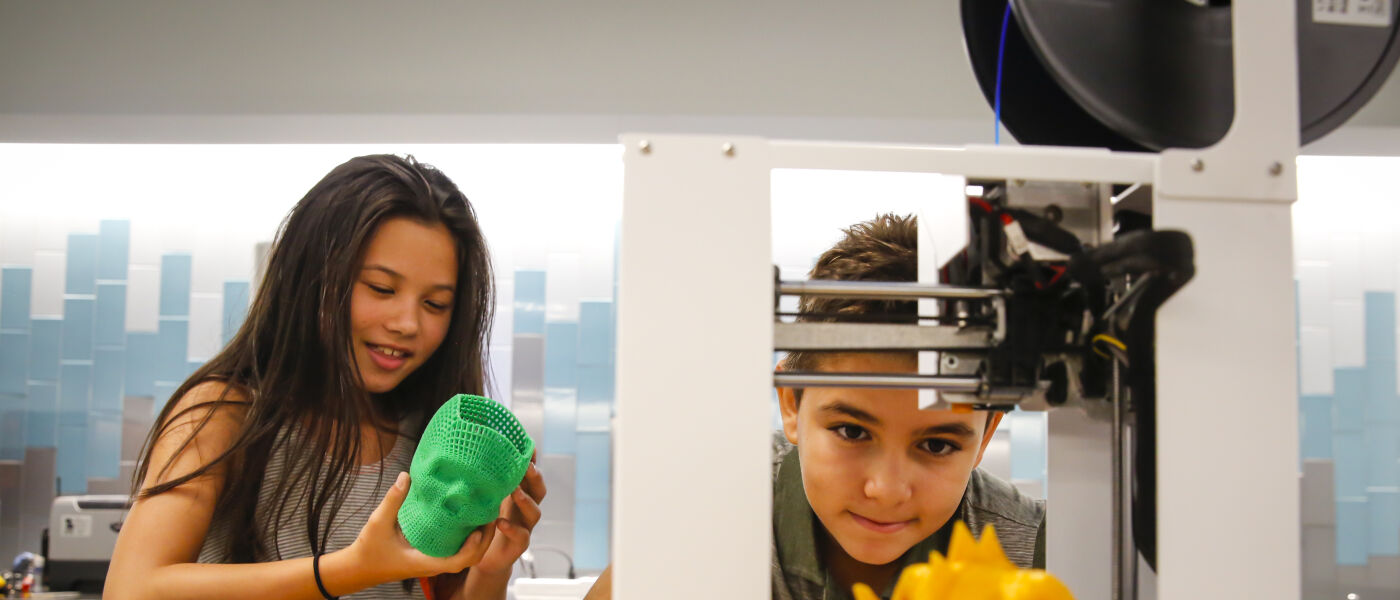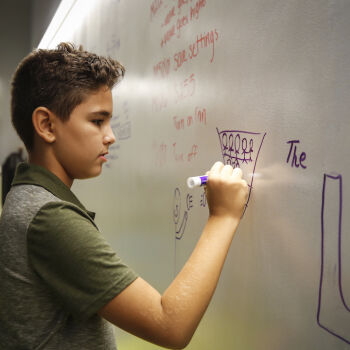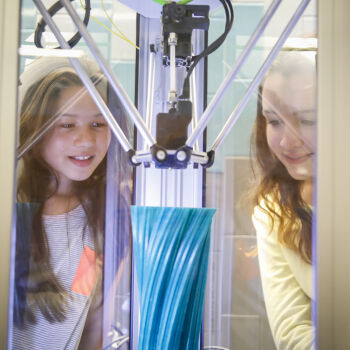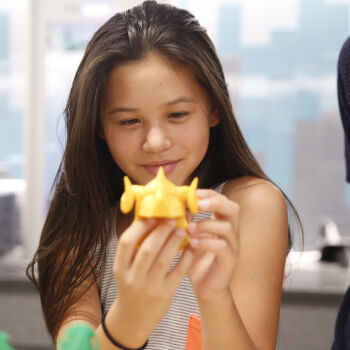Maker & Tech
LSC’s MakerLab and Tech & Design Studio bring technology and creativity to life.
MakerLab workshops celebrate and encourage the creative, curious, and inventive spirits that all students have. The maker culture is at the heart of these workshops where students will use 3-D software to design innovative solutions for tomorrow’s problems.
Tech & Design Studio workshops introduce exciting technology skills to students. Each student works to apply computational thinking and design principles to identify solutions or create dynamic projects.
Programs must be booked in advance. Please call 201.253.1337, email partnerships@lsc.org, or fill out our info form.
Grades Pre-K – 2
Biomimicry to Me (Five Sessions; Each 45 Minutes)
Available at LSC or at your school. Everyone loves animals! But did you know that we can copy our favorite animals’ special qualities to create inventions? That’s called biomimicry! In this series, learn all about what adaptations are, how they help animals survive in their unique environments, and how we mimic these solutions to solve everyday problems. Help apply what you learn throughout the series to solve a problem and design a unique solution with 3D printing pens. Alignment to NJSLS - Science: 1-LS1-1 Use materials to design a solution to a human problem by mimicking how plants and/or animals use their external parts to help them survive, grow, and meet their needs. K-2-ETS1-3 Analyze data from tests of two objects designed to solve the same problem to compare the strengths and weaknesses of how each performs.
Grades 3 – 5
Intro to 3D Design with Tinkercad (45-60 Minutes)
Available online or at LSC. Learn the basics of 3D design using the open-source software Tinkercad to design and create a custom desk name plate. Each student will need a computer and a Tinkercad account. Alignment to NJSLS - Science: 3-5-ETS1-1 Define a simple design problem reflecting a need or a want that includes specified criteria for success and constraints on materials, time, or cost. Connections to NJSLS - Mathematics: MP.4 - Model with mathematics. Alignment to NJSLS - Computer Science and Design Thinking: 8.2.5.ITH.2 Evaluate how well a new tool has met its intended purpose and identify any shortcomings it might have. 8.2.5.ED.2: Collaborate with peers to collect information, brainstorm to solve a problem, and evaluate all possible solutions to provide the best results with supporting sketches or models.
Getting Started with AI (45 Minutes)
Available online or at LSC. How do machines know what they know? In this introduction to artificial intelligence, examine the concept of intelligence through interactive activities like intelligent paper and an invisible maze game. Gain a deeper understanding that intelligence goes beyond simple storage of knowledge. Alignment to NJSLS - Science: 3-5-ETS1-2 Generate and compare multiple possible solutions to a problem based on how well each is likely to meet the criteria and constraints of the problem. Connection to NJSLS - English Language Arts: RI.5.9 Integrate information from several texts on the same topic in order to write or speak about the subject knowledgeably. Connection to NJSLS - Mathematics: MP.5 Use appropriate tools strategically. Connection to NJSLS - Computer Science and Design Thinking: 8.2.5.ITH.2: Evaluate how well a new tool has met its intended purpose and identify any shortcomings it might have.
Arduino: Morse Code (45 Minutes)
Available online or at LSC. Learn the basics of Arduino programming and circuit design while applying scientific ideas to design, test, and refine a device that converts electrical energy into light energy to transmit Morse code signals. Alignment to NJSLS - Science: 3-5-ETS1-2 Generate and compare multiple possible solutions to a problem based on how well each is likely to meet the criteria and constraints of the problem. Connection to NJSLS - Computer Science and Design Thinking: 8.1.5.AP.6: Develop programs using an iterative process, implement the program design, and test the program to ensure it works as intended.
Arduino: Traffic Light (45 Minutes)
Available online or at LSC. Learn about African-American trailblazer Garrett Morgan and his inventions, specifically the improved traffic light. Use open source software to code a traffic light and, as a team, come up with an improvement to the design. Alignment to NJSLS - Science: 4-PS3-4 Apply scientific ideas to design, test, and refine a device that converts energy from one form to another. 3-5-ETS1-2 Generate and compare multiple possible solutions to a problem based on how well each is likely to meet the criteria and constraints of the problem. Connection to NJSLS - English Language Arts: W.4.8 - Recall relevant information from experiences or gather relevant information from print and digital sources; take notes and categorize information, and provide a list of sources. Connection to NJSLS - Computer Science and Design Thinking: 8.1.5.CS.2: Model how computer software and hardware work together as a system to accomplish tasks.
Bubble-tastic Engineering (45 Minutes)
Available online or at LSC. Unleash your bubble-tential and get ready to blow away the competition! In this program you will design a custom bubble-blowing device. Dive into the chemistry of these iridescent spheres, then mix and stir your way to the ideal bubble solution. Alignment to NJSLS - Science: 5-PS1-4: Conduct investigations to determine whether the mixing of two or more substances results in new substances. 3-5-ETS1-2: Generate and compare multiple possible solutions to a problem based on how well each is likely to meet the criteria and constraints of the problem. Connection to NJSLS - English Language Arts: W.5.7 Conduct short research projects that use several sources to build knowledge through investigation. Connection to NJSLS - Mathematics: MP.5 Use appropriate tools strategically.
Coding Sphero (45 Minutes)
Available online or at LSC. Want to see your code come to life? Using a user-friendly, web-based computer science coding program, create a code to navigate a virtual rover through a maze. Your challenge, should you choose to accept it, is to try to make your code as efficient as it is effective. Alignment to NJSLS - Science: 3-5-ETS1-3 Plan and carry out fair tests in which variables are controlled and failure points are considered to identify aspects of a model or prototype that can be improved. 3-PS2-2 Make observations and/or measurements of an object’s motion to provide evidence that a pattern can be used to predict future motion. Alignment to NJSLS - Computer Science & Design Thinking: 8.1.5.AP.4: Break down problems into smaller, manageable sub-problems to facilitate program development. 8.1.5.DA.5 Propose cause and effect relationships, predict outcomes, or communicate ideas using data. 8.1.5.AP.1: Compare and refine multiple algorithms for the same task and determine which is the most appropriate. 8.1.5.AP.3: Create programs that include sequences, events, loops, and conditionals. Connections to NJSLS - Mathematics: MP.2 Reason abstractly and quantitatively.
Grades 6 – 8
Design Thinking with Tinkercad (60-75 Minutes)
Available online or at LSC. Engage in the online digital creation of 3D models. Choose from three intriguing projects, each packed with excitement and innovation, and all achievable within a 45-minute timeframe.
- Project 1: Craft a Better Spoon for Toddlers - Design a toddler-friendly utensil that makes mealtime enjoyable, safe, and engaging.
- Project 2: Design a Medical Container or Eating Device for Parkinson's Patients - Enhance their independence, minimize spills, and ensure a comfortable dining experience.
- Project 3: Innovate a Solution for a Flood - Confront the critical challenge of designing a flood solution that mitigates the impact of floods and safeguards communities.
Alignment to NJSLS - Computer Science and Design Thinking: 8.2.8.ED.1 Evaluate the function, value, and aesthetics of a technological product or system, from the perspective of the user and the producer. 8.1.8.ED.3 Develop a proposal for a solution to a real-world problem that includes a model (e.g., physical prototype, graphical/technical sketch). Connections to NJSLS - Mathematics: MP.2 Reason abstractly and quantitatively.
Intro to 3D Design with Tinkercad (45-60 Minutes)
Available online or at LSC. Engage in the digital creation of 3D models and learn how to create intricate pieces designed for 3D printing using Autodesk Tinkercad. Alignment to NJSLS - Science: MS-ETS1-4 Develop a model to generate data for iterative testing and modification of a proposed object, tool, or process such that an optimal design can be achieved. Alignment to NJSLS - Computer Science and Design Thinking: 8.2.8.ED.1 Evaluate the function, value, and aesthetics of a technological product or system, from the perspective of the user and the producer. Connections to NJSLS - English Language Arts: SL.8.5 Integrate multimedia and visual displays into presentations to clarify information, strengthen claims and evidence, and add interest. Connections to NJSLS - Mathematics: MP.2 Reason abstractly and quantitatively.
Intro to Game Design (45-60 Minutes)
Available online or at LSC. Design custom characters, animations, and behaviors for video games. Use the platform Scratch to build a foundation for computational thinking, an essential skill in today’s tech-driven world. Alignment to NJSLS - Science: MS-ETS1-2 Evaluate competing design solutions using a systematic process to determine how well they meet the criteria and constraints of the problem. Alignment to NJSLS - Computer Science and Design Thinking: 8.2.8.ED.1 Evaluate the function, value, and aesthetics of a technological product or system, from the perspective of the user and the producer. 8.2.8.ED.4 Investigate a malfunctioning system, identify its impact, and explain the step-by-step process used to troubleshoot, evaluate, and test options to repair the product in a collaborative team. Connections to NJSLS - Mathematics: MP.2 Reason abstractly and quantitatively. 7.EE.3 Solve multi-step real-life and mathematical problems posed with positive and negative rational numbers in any form (whole numbers, fractions, and decimals), using tools strategically. Apply properties of operations to calculate with numbers in any form; convert between forms as appropriate; and assess the reasonableness of answers using mental computation and estimation strategies.
Coding Sphero: Golf (45 Minutes)
Available at LSC. Tee off into an adventure in the world of golf with Sphero, where precision meets strategy. Code and master the perfect roll, angles, and more. Alignment to NJSLS - Science: MS-ETS1-4 Develop a model to generate data for iterative testing and modification of a proposed object, tool, or process such that an optimal design can be achieved. Connection to NJSLS - English Language Arts: SL.8.5 Integrate multimedia and visual displays into presentations to clarify information, strengthen claims and evidence, and add interest. Connection to NJSLS - Mathematics: MP.2 Reason abstractly and quantitatively. Connection to NJSLS - Computer Science and Design Thinking: 8.1.8.AP.3 Design and iteratively develop programs that combine control structures, including nested loops and compound conditionals.
3D Printed Blinking Eye (45 Minutes)
Available at LSC. Combine coding and 3D printing technology with this exciting program. Construct a pre-printed 3D eye and program the printed eye to blink realistically using the iterative process and the C++ coding language. Alignment to NJSLS - Science: MS-ETS1-1 Define the criteria and constraints of a design problem with sufficient precision to ensure a successful solution, taking into account relevant scientific principles and potential impacts on people and the natural environment that may limit possible solutions. Connection to NJSLS - Mathematics: MP.2 Reason abstractly and quantitatively. Connection to NJSLS - Computer Science and Design Thinking: 8.1.8.AP.6: Refine a solution that meets users’ needs by incorporating feedback from team members and users.
Communicating Science with Pixel Art (45 Minutes)
Available online or at LSC. Discover the art of communicating science through pixel art! In this program, science and art converge to create digital illustrations or animations to showcase the phenomenon of light and its effects on droplets of water. Use an intuitive online STEAM toolset to explore physics in an mesmerizing way. Alignment to NJSLS - Science: MS-PS4-2 Develop and use a model to describe that waves are reflected, absorbed, or transmitted through various materials. Connection to NJSLS - English Language Arts: SL.8.5 Integrate multimedia and visual displays into presentations to clarify information, strengthen claims and evidence, and add interest.
Coding Sphero: Navigation (45 Minutes)
Available at LSC. Congratulations! You have been hired by a cutting-edge company developing obstacle detection using the Sphero bolt robot. In this program, your students will read and modify code in JavaScript to enhance their spheros' movement and understand the job of software engineering. Alignment to NJSLS - Science: MS-ETS1-2 Evaluate competing design solutions using a systematic process to determine how well they meet the criteria and constraints of the problem. Connection to NJSLS - English Language Arts: RST.6-8.9 Compare and contrast the information gained from experiments, simulations, video, or multimedia sources with that gained from reading a text on the same topic. Connection to NJSLS - Mathematics: 7.EE.3 Solve multi-step real-life and mathematical problems posed with positive and negative rational numbers in any form (whole numbers, fractions, and decimals), using tools strategically. Apply properties of operations to calculate with numbers in any form; convert between forms as appropriate; and assess the reasonableness of answers using mental computation and estimation strategies. Connection to NJSLS - Computer Science and Design Thinking: 8.1.8.AP.4: Decompose problems and subproblems into parts to facilitate the design, implementation, and review of programs.
Grades 9 – 12
Colonizing Mars (60-75 Minutes)
Available at LSC. Can humans overcome Mars’ harsh environment and live there one day? Design a habitat for life on Mars based on a topographic map given to you by LSC that resembles an actual Martian location. Modify the terrain as needed, build your 3D model of your Martian home and share your methods. Alignment to NJSLS - Science: HS-ESS3-2 Evaluate competing design solutions for developing, managing, and utilizing energy and mineral resources based on cost-benefit ratios. Connections to NJSLS - Mathematics: MP.2 Reason abstractly and quantitatively. Alignment to NJSLS - Computer Science and Design Thinking: 8.2.12.ITH.2 Propose an innovation to meet future demands supported by an analysis of the potential costs, benefits, trade-offs, and risks related to the use of the innovation. 8.2.12.ED.2: Create scaled engineering drawings for a new product or system and make modification to increase optimization based on feedback
Design Thinking with Tinkercad (60-75 Minutes)
Available online or at LSC. Engage in the online digital creation of 3d models. Choose from three intriguing projects, each packed with excitement and innovation, and all achievable within a 45-minute timeframe.
- Project 1: Craft a Better Spoon for Toddlers - Design a toddler-friendly utensil that makes mealtime enjoyable, safe, and engaging.
- Project 2: Design a Medical Container or Eating Device for Parkinson's Patients - Enhance their independence, minimize spills, and ensure a comfortable dining experience.
- Project 3: Innovate a Solution for a Flood - Confront the critical challenge of designing a flood solution that mitigates the impact of floods and safeguards communities.
Alignment to NJSLS - Science: HS-ETS1-2 Design a solution to a complex real-world problem by breaking it down into smaller, more manageable problems that can be solved through engineering. Connections to NJSLS - Mathematics: MP.4 Model with mathematics. Alignment to NJSLS - Computer Science and Design Thinking: 8.2.12.NT.2 Redesign an existing product to improve form or function.
Intro to 3D Design with Tinkercad (45-60 Minutes)
Available online or at LSC. Engage in the digital creation of 3D models and learn how to create intricate pieces designed for 3D printing using Autodesk Tinkercad. Alignment to NJSLS - Science: HS-ETS1-2 Design a solution to a complex real-world problem by breaking it down into smaller, more manageable problems that can be solved through engineering. Alignment to NJSLS - Computer Science and Design Thinking: 8.2.12.NT.2 Redesign an existing product to improve form or function. Connections to NJSLS - Mathematics: MP.4 Model with mathematics.
Flow Wars: The Battle of Fluid Dynamics (60 Minutes)
Available at LSC. Master the art of design optimization and take a macro look at molecular structures. Your team is on the hook to build hydrodynamic structures, communicate your technical process, and prove why understanding molecular design is vital for the functioning of macroscopic materials. Alignment to NJSLS - Science: HS-PS2-6 Communicate scientific and technical information about why the molecular-level structure is important in the functioning of designed materials. Connection to NJSLS - English Language Arts: WHST.9-12.2 Write informative/explanatory texts, including the narration of historical events, scientific procedures/ experiments, or technical processes. Connection to NJSLS - Mathematics: HSN-Q.A.1 Use units as a way to understand problems and to guide the solution of multi-step problems; choose and interpret units consistently in formulas; choose and interpret the scale and the origin in graphs and data displays.
Coming in Hot! Thermodynamics (60 Minutes)
Available at LSC. Master the laws of thermodynamics through hands-on design work! In this program, you have been hired by GrubClub to craft a new low-cost delivery box that can handle scorching heat and blistering cold at the same time. Learn about calorimetry and insulation as you build a prototype to face this challenge. Alignment to NJSLS - Science: HS-PS3-4 Plan and conduct an investigation to provide evidence that the transfer of thermal energy when two components of different temperature are combined within a closed system results in a more uniform energy distribution among the components in the system (second law of thermodynamics). Connection to NJSLS - Mathematics: MP.4 Model with mathematics.
Coding Sphero: Navigation (45 Minutes)
Available at LSC. Congratulations! You have been hired by a cutting-edge company developing obstacle detection using the sphero bolt robot. In this program, your students will read and modify code in JavaScript to enhance their spheros' movement and understand the job of software engineering. Alignment to NJSLS - Science: HS-ETS1-2 Design a solution to a complex real-world problem by breaking it down into smaller, more manageable problems that can be solved through engineering. Connection to NJSLS - Mathematics: MP.4 Model with mathematics. Connection to NJSLS - Computer Science and Design Thinking: 8.1.12.AP.5 Decompose problems into smaller components through systematic analysis, using constructs such as procedures, modules, and/or objects.
MakerLab Plus! SURE House: A Virtual Exhibition Tour
Add to any Maker & Tech session!
Experience Liberty Science Center's SUstainable + REsilient SURE House! Take a virtual tour of this award-winning, storm-resistant, energy-efficient beach house, designed by Stevens Institute of Technology students. Discover how it uses 90 percent less energy than a traditional home and serves as a hub for emergency power to other buildings in the aftermath of a storm.
SURE House: A Virtual Exhibition Tour can be added to any Maker & Tech session.




